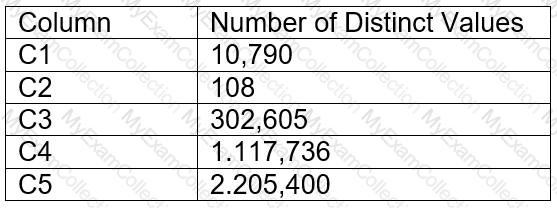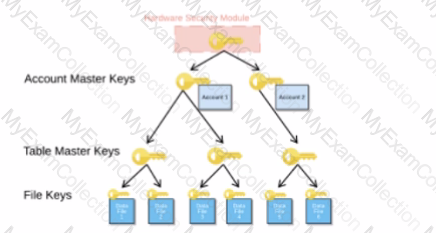An Architect on a new project has been asked to design an architecture that meets Snowflake security, compliance, and governance requirements as follows:
1) Use Tri-Secret Secure in Snowflake
2) Share some information stored in a view with another Snowflake customer
3) Hide portions of sensitive information from some columns
4) Use zero-copy cloning to refresh the non-production environment from the production environment
To meet these requirements, which design elements must be implemented? (Choose three.)
The data share exists between a data provider account and a data consumer account. Five tables from the provider account are being shared with the consumer account. The consumer role has been granted the imported privileges privilege.
What will happen to the consumer account if a new table (table_6) is added to the provider schema?
How is the change of local time due to daylight savings time handled in Snowflake tasks? (Choose two.)
A user named USER_01 needs access to create a materialized view on a schema EDW. STG_SCHEMA. How can this access be provided?
Based on the Snowflake object hierarchy, what securable objects belong directly to a Snowflake account? (Select THREE).
An Architect for a multi-national transportation company has a system that is used to check the weather conditions along vehicle routes. The data is provided to drivers.
The weather information is delivered regularly by a third-party company and this information is generated as JSON structure. Then the data is loaded into Snowflake in a column with a VARIANT data type. This
table is directly queried to deliver the statistics to the drivers with minimum time lapse.
A single entry includes (but is not limited to):
- Weather condition; cloudy, sunny, rainy, etc.
- Degree
- Longitude and latitude
- Timeframe
- Location address
- Wind
The table holds more than 10 years' worth of data in order to deliver the statistics from different years and locations. The amount of data on the table increases every day.
The drivers report that they are not receiving the weather statistics for their locations in time.
What can the Architect do to deliver the statistics to the drivers faster?
An Architect is troubleshooting a query with poor performance using the QUERY function. The Architect observes that the COMPILATION_TIME Is greater than the EXECUTION_TIME.
What is the reason for this?
A retail company has over 3000 stores all using the same Point of Sale (POS) system. The company wants to deliver near real-time sales results to category managers. The stores operate in a variety of time zones and exhibit a dynamic range of transactions each minute, with some stores having higher sales volumes than others.
Sales results are provided in a uniform fashion using data engineered fields that will be calculated in a complex data pipeline. Calculations include exceptions, aggregations, and scoring using external functions interfaced to scoring algorithms. The source data for aggregations has over 100M rows.
Every minute, the POS sends all sales transactions files to a cloud storage location with a naming convention that includes store numbers and timestamps to identify the set of transactions contained in the files. The files are typically less than 10MB in size.
How can the near real-time results be provided to the category managers? (Select TWO).
Company A would like to share data in Snowflake with Company B. Company B is not on the same cloud platform as Company A.
What is required to allow data sharing between these two companies?
Which statements describe characteristics of the use of materialized views in Snowflake? (Choose two.)
Company A has recently acquired company B. The Snowflake deployment for company B is located in the Azure West Europe region.
As part of the integration process, an Architect has been asked to consolidate company B's sales data into company A's Snowflake account which is located in the AWS us-east-1 region.
How can this requirement be met?
An Architect clones a database and all of its objects, including tasks. After the cloning, the tasks stop running.
Why is this occurring?
A table contains five columns and it has millions of records. The cardinality distribution of the columns is shown below:

Column C4 and C5 are mostly used by SELECT queries in the GROUP BY and ORDER BY clauses. Whereas columns C1, C2 and C3 are heavily used in filter and join conditions of SELECT queries.
The Architect must design a clustering key for this table to improve the query performance.
Based on Snowflake recommendations, how should the clustering key columns be ordered while defining the multi-column clustering key?
A company’s daily Snowflake workload consists of a huge number of concurrent queries triggered between 9pm and 11pm. At the individual level, these queries are smaller statements that get completed within a short time period.
What configuration can the company’s Architect implement to enhance the performance of this workload? (Choose two.)
Which data models can be used when modeling tables in a Snowflake environment? (Select THREE).
When activating Tri-Secret Secure in a hierarchical encryption model in a Snowflake account, at what level is the customer-managed key used?

Which of the following are characteristics of Snowflake’s parameter hierarchy?
An Architect is integrating an application that needs to read and write data to Snowflake without installing any additional software on the application server.
How can this requirement be met?
Which steps are recommended best practices for prioritizing cluster keys in Snowflake? (Choose two.)
Which of the following are characteristics of how row access policies can be applied to external tables? (Choose three.)
A company is using Snowflake in Azure in the Netherlands. The company analyst team also has data in JSON format that is stored in an Amazon S3 bucket in the AWS Singapore region that the team wants to analyze.
The Architect has been given the following requirements:
1. Provide access to frequently changing data
2. Keep egress costs to a minimum
3. Maintain low latency
How can these requirements be met with the LEAST amount of operational overhead?
A large manufacturing company runs a dozen individual Snowflake accounts across its business divisions. The company wants to increase the level of data sharing to support supply chain optimizations and increase its purchasing leverage with multiple vendors.
The company’s Snowflake Architects need to design a solution that would allow the business divisions to decide what to share, while minimizing the level of effort spent on configuration and management. Most of the company divisions use Snowflake accounts in the same cloud deployments with a few exceptions for European-based divisions.
According to Snowflake recommended best practice, how should these requirements be met?
An Architect has been asked to clone schema STAGING as it looked one week ago, Tuesday June 1st at 8:00 AM, to recover some objects.
The STAGING schema has 50 days of retention.
The Architect runs the following statement:
CREATE SCHEMA STAGING_CLONE CLONE STAGING at (timestamp => '2021-06-01 08:00:00');
The Architect receives the following error: Time travel data is not available for schema STAGING. The requested time is either beyond the allowed time travel period or before the object creation time.
The Architect then checks the schema history and sees the following:
CREATED_ON|NAME|DROPPED_ON
2021-06-02 23:00:00 | STAGING | NULL
2021-05-01 10:00:00 | STAGING | 2021-06-02 23:00:00
How can cloning the STAGING schema be achieved?
A company is designing high availability and disaster recovery plans and needs to maximize redundancy and minimize recovery time objectives for their critical application processes. Cost is not a concern as long as the solution is the best available. The plan so far consists of the following steps:
1. Deployment of Snowflake accounts on two different cloud providers.
2. Selection of cloud provider regions that are geographically far apart.
3. The Snowflake deployment will replicate the databases and account data between both cloud provider accounts.
4. Implementation of Snowflake client redirect.
What is the MOST cost-effective way to provide the HIGHEST uptime and LEAST application disruption if there is a service event?
An Architect is implementing a CI/CD process. When attempting to clone a table from a production to a development environment, the cloning operation fails.
What could be causing this to happen?
A company is designing its serving layer for data that is in cloud storage. Multiple terabytes of the data will be used for reporting. Some data does not have a clear use case but could be useful for experimental analysis. This experimentation data changes frequently and is sometimes wiped out and replaced completely in a few days.
The company wants to centralize access control, provide a single point of connection for the end-users, and maintain data governance.
What solution meets these requirements while MINIMIZING costs, administrative effort, and development overhead?
An Architect needs to grant a group of ORDER_ADMIN users the ability to clean old data in an ORDERS table (deleting all records older than 5 years), without granting any privileges on the table. The group’s manager (ORDER_MANAGER) has full DELETE privileges on the table.
How can the ORDER_ADMIN role be enabled to perform this data cleanup, without needing the DELETE privilege held by the ORDER_MANAGER role?
An Architect is troubleshooting a query with poor performance using the QUERY_HIST0RY function. The Architect observes that the COMPILATIONJHME is greater than the EXECUTIONJTIME.
What is the reason for this?
Which organization-related tasks can be performed by the ORGADMIN role? (Choose three.)
An Architect with the ORGADMIN role wants to change a Snowflake account from an Enterprise edition to a Business Critical edition.
How should this be accomplished?
How can the Snowflake context functions be used to help determine whether a user is authorized to see data that has column-level security enforced? (Select TWO).
What are some of the characteristics of result set caches? (Choose three.)
An Architect needs to design a solution for building environments for development, test, and pre-production, all located in a single Snowflake account. The environments should be based on production data.
Which solution would be MOST cost-effective and performant?
What actions are permitted when using the Snowflake SQL REST API? (Select TWO).
What integration object should be used to place restrictions on where data may be exported?
An Architect entered the following commands in sequence:

USER1 cannot find the table.
Which of the following commands does the Architect need to run for USER1 to find the tables using the Principle of Least Privilege? (Choose two.)
A user is executing the following command sequentially within a timeframe of 10 minutes from start to finish:

What would be the output of this query?
When loading data into a table that captures the load time in a column with a default value of either CURRENT_TIME () or CURRENT_TIMESTAMP () what will occur?
Which columns can be included in an external table schema? (Select THREE).
Data is being imported and stored as JSON in a VARIANT column. Query performance was fine, but most recently, poor query performance has been reported.
What could be causing this?

